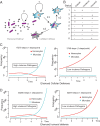Variation of TNF modulates cellular immunity of gregarious and solitary locusts against fungal pathogen Metarhizium anisopliae
- PMID: 35110413
- PMCID: PMC8833202
- DOI: 10.1073/pnas.2120835119
Variation of TNF modulates cellular immunity of gregarious and solitary locusts against fungal pathogen Metarhizium anisopliae
Abstract
Changes in population density lead to phenotypic differentiation of solitary and gregarious locusts, which display different resistance to fungal pathogens; however, how to regulate their cellular immune strategies remains unknown. Here, our stochastic simulation of pathogen proliferation suggested that humoral defense always enhanced resistance to fungal pathogens, while phagocytosis sometimes reduced defense against pathogens. Further experimental data proved that gregarious locusts had significantly decreased phagocytosis of hemocytes compared to solitary locusts. Additionally, transcriptional analysis showed that gregarious locusts promoted immune effector expression (gnbp1 and dfp) and reduced phagocytic gene expression (eater) and the cytokine tumor necrosis factor (TNF). Interestingly, higher expression of the cytokine TNF in solitary locusts simultaneously promoted eater expression and inhibited gnbp1 and dfp expression. Moreover, inhibition of TNF increased the survival of solitary locusts, and injection of TNF decreased the survival of gregarious locusts after fungal infection. Therefore, our results indicate that the alerted expression of TNF regulated the immune strategy of locusts to adapt to environmental changes.
Keywords: cellular defenses; density-dependent prophylaxis; ecological immunology; tumor necrosis factor.
Copyright © 2022 the Author(s). Published by PNAS.
Conflict of interest statement
The authors declare no competing interest.
Figures





Similar articles
-
Host-Pathogen Interactions between Metarhizium spp. and Locusts.J Fungi (Basel). 2022 Jun 3;8(6):602. doi: 10.3390/jof8060602. J Fungi (Basel). 2022. PMID: 35736085 Free PMC article. Review.
-
Altered immunity in crowded locust reduced fungal (Metarhizium anisopliae) pathogenesis.PLoS Pathog. 2013 Jan;9(1):e1003102. doi: 10.1371/journal.ppat.1003102. Epub 2013 Jan 10. PLoS Pathog. 2013. PMID: 23326229 Free PMC article.
-
Crowded locusts produce hatchlings vulnerable to fungal attack.Biol Lett. 2009 Dec 23;5(6):845-8. doi: 10.1098/rsbl.2009.0495. Epub 2009 Aug 12. Biol Lett. 2009. PMID: 19675004 Free PMC article.
-
HYD3, a conidial hydrophobin of the fungal entomopathogen Metarhizium acridum induces the immunity of its specialist host locust.Int J Biol Macromol. 2020 Dec 15;165(Pt A):1303-1311. doi: 10.1016/j.ijbiomac.2020.09.222. Epub 2020 Oct 3. Int J Biol Macromol. 2020. PMID: 33022346
-
Phenotypic Plasticity in Locusts: Trade-Off Between Migration and Reproduction.Annu Rev Entomol. 2025 Jan;70(1):23-44. doi: 10.1146/annurev-ento-013124-124333. Epub 2024 Dec 19. Annu Rev Entomol. 2025. PMID: 39227131 Review.
Cited by
-
Host-Pathogen Interactions between Metarhizium spp. and Locusts.J Fungi (Basel). 2022 Jun 3;8(6):602. doi: 10.3390/jof8060602. J Fungi (Basel). 2022. PMID: 35736085 Free PMC article. Review.
-
TNF signaling mediates cellular immune function and promotes malaria parasite killing in the mosquito Anopheles gambiae.PLoS Pathog. 2025 Jul 3;21(7):e1013329. doi: 10.1371/journal.ppat.1013329. eCollection 2025 Jul. PLoS Pathog. 2025. PMID: 40608824 Free PMC article.
-
Glutamate-GABA imbalance mediated by miR-8-5p and its STTM regulates phase-related behavior of locusts.Proc Natl Acad Sci U S A. 2023 Jan 3;120(1):e2215660120. doi: 10.1073/pnas.2215660120. Epub 2022 Dec 27. Proc Natl Acad Sci U S A. 2023. PMID: 36574679 Free PMC article.
-
Multi-Omics Reveals the Effect of Population Density on the Phenotype, Transcriptome and Metabolome of Mythimna separata.Insects. 2023 Jan 10;14(1):68. doi: 10.3390/insects14010068. Insects. 2023. PMID: 36661996 Free PMC article.
-
TNF signaling mediates cellular immune function and promotes malaria parasite killing in the mosquito Anopheles gambiae.bioRxiv [Preprint]. 2024 May 5:2024.05.02.592209. doi: 10.1101/2024.05.02.592209. bioRxiv. 2024. Update in: PLoS Pathog. 2025 Jul 3;21(7):e1013329. doi: 10.1371/journal.ppat.1013329. PMID: 38746363 Free PMC article. Updated. Preprint.
References
Publication types
MeSH terms
Substances
LinkOut - more resources
Full Text Sources

